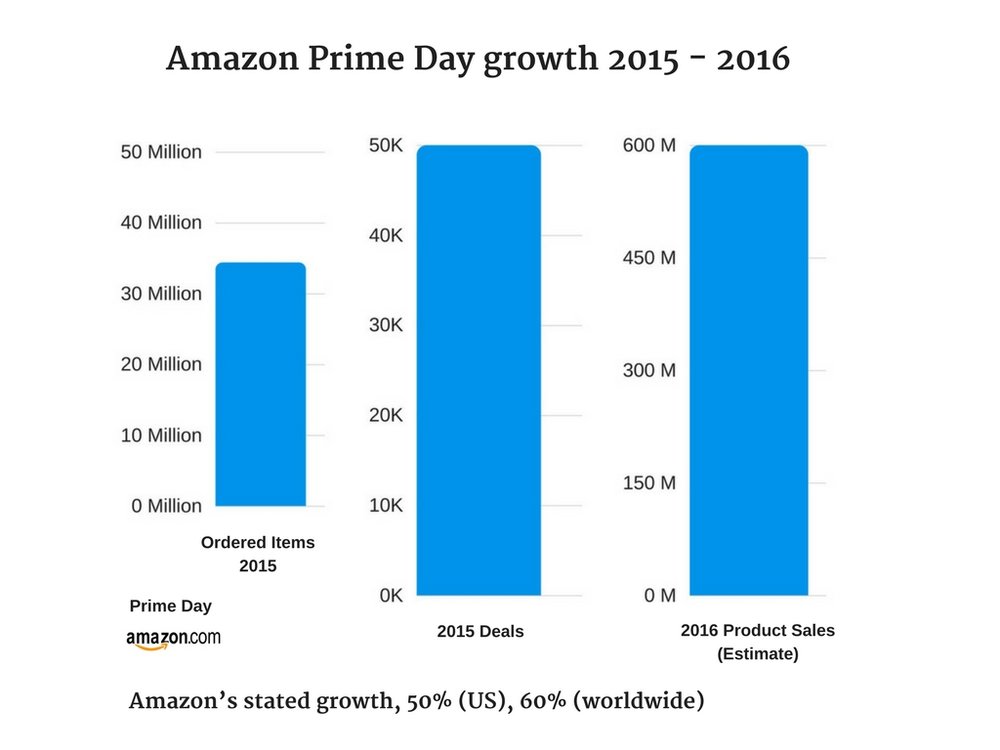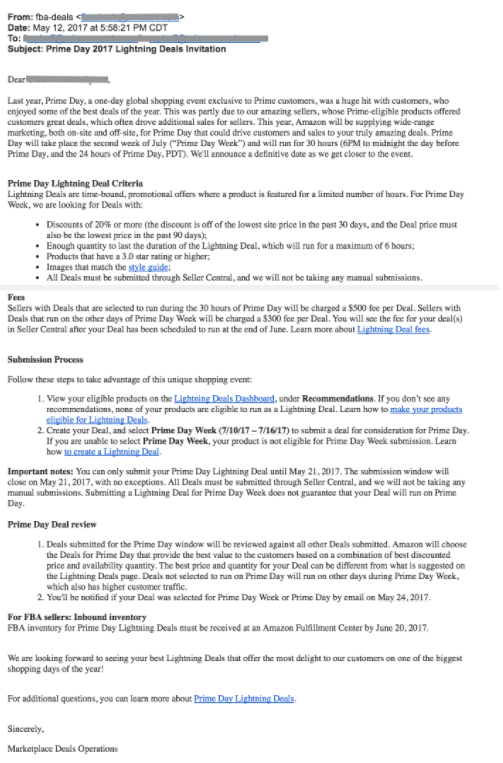In July 2017, Amazon will host its third Prime Day, a 30-hour retail event exclusively for Prime members. It’s Amazon’s birthday celebration, but instead of expecting to receive gifts, Amazon invites customers to buy some for themselves!
With the past two Prime Days producing record-breaking sales for brands selling on Amazon, this event can actually be considered a gift to brands. The exact date for this year’s Prime Day hasn’t been announced yet, but we know that it will be some time between July 10 and July 16. Unlike past years when it was a 24-hour event, this year Prime Day will run for 30 hours (from 6:00 p.m. to midnight PDT on the day before Prime Day, plus the 24 hours of Prime Day itself). It’s basically a day and a half of deals and discounts for Prime members. Amazon has also alluded to the possibility of a “Prime Day Week” this year, which might mean they have plans to promote more than just a single day of deals.
The past two Prime Day events were held on the second Tuesday of July, so it seems likely that Prime Day 2017 will fall on July 11. No matter which date Amazon chooses, there are approximately seven weeks till the big day, and brands need to start preparing now in order to make the most of it.
Why Prime Day is a big deal for brands selling on Amazon
- Orders on Prime Day are huge compared with orders on other days. Not only that, but Prime Day sales in 2016 were much higher than in 2015, and we expect 2017 to continue this trajectory.
- At least 50 percent of the orders placed on Prime Day 2016 were from Third-Party Sellers (i.e., brands that sell on the Seller Central platform), meaning that Prime Day is not just a day for Amazon to hawk its own inventory.

- Finally, Prime Day is nicely timed in the middle of summer when retail sales are generally slow, making it a nice opportunity for brands that need a mid-year sales boost to smooth out their cash flow.
How to know if you’re invited
Every year Amazon handpicks some Sellers to run official Prime Day deals. The Sellers chosen for 2017 received messages from Amazon during the week of May 15 inviting them to submit Lightning Deals for Prime Day. However, keep in mind that receiving an invitation does not guarantee that your deal will actually run.

Invite for Prime Day 2017
Amazon specified in the invitation exactly what it’s looking for when deciding which Deals will run:
- Discounts of 20 percent or more. (The discount should be taken off of the lowest site price in the past 30 days, and the Deal price must be the lowest price in the past 90 days.)
- Enough quantity to last the duration of the Lightning Deal, which will run for a maximum of six hours.
- Products that have a 3-star rating or higher.
- Images that match the style guide.
- Deals that have been submitted through Seller Central; Amazon will not be taking any manual submissions.
According to an invitation received by one of our clients, brands that are selected to run a Deal during Prime Day will be charged a $500 fee per Deal.
What to do if you’re not invited
Even if your brand is not selected for an official Lightning Deal, you can still take advantage of a halo effect generated by the buzz of Prime Day. Because it’s such a highly publicized event, people will be logging on to Amazon in droves to check out deals and purchase things they’ve had their eyes on for a while.
Here’s the 3-step Prime Day strategy we’re putting in place for clients of Bobsled Marketing in 2017.
1. INVENTORY PLANNING
Review your current assortment of products and decide which ones you want to promote. Then stock up! Running out of stock is a guaranteed way to miss out on the boosted traffic and open wallets of Prime Day. Amazon suggests having your inventory arrive at its fulfillment centers before June 20. Don’t leave this till the last minute because fulfillment centers are likely to be overwhelmed with inbound shipments and may take longer than usual to receive your inventory.
2. MAKE YOUR OWN DEALS
Catch the attention of shoppers on Prime Day with some genuinely attractive discounts on your products.
- You can set up promotion rules to run over the Prime Day period.
- If a customer has a product saved in their Wish List or Shopping Cart and the price of the product changes, they will get a notification at checkout, so take advantage of this feature. Simply changing the price of some of your products may prompt customers to place an order they’d been holding off on—possibly for a higher quantity than they originally had in mind.

- Besides discounting, what other kinds of deals can you run? One option—if you fulfill some SKUs yourself—is to offer free premium shipping on those SKUs. Two-for-one deals are another great option. These and other promotions can help with cross-selling throughout your assortment, which boosts your Average Order Value, a significant profitability driver on Amazon.
- Note that Amazon does not allow qualifiers like “Prime Day Deal” or “On Sale” in the titles of product listings, so be sure to avoid those.
3. GET YOUR DEALS FOUND WITH PPC
Amazon has reported that “clicks on product advertisements paid for by Third-Party Sellers grew 150 percent” on 2016’s Prime Day. This tells us that investing in PPC (Pay-Per-Click) advertising definitely works to maximize the number of eyes on all the great deals and promotions you have planned. The best way to drive awareness and traffic to your product listings is through PPC campaigns. Amazon Sponsored Products can help your products surface at a higher place in organic search results, and other ad types like Product Display ads and Headline Search ads can even direct potential customers away from competitors and toward your product listings.
Our PPC team recommends adding specific search terms focused around Prime Day and being more aggressive with bids.
With just seven weeks to go, now is the time to start planning your Prime Day strategy. We anticipate 2017 to be the biggest year yet in Prime Day’s short history, so make sure that your brand takes full advantage of this big opportunity.
Tagged: PPC Advertising, Seller & Vendor Central, Operations
.png)

